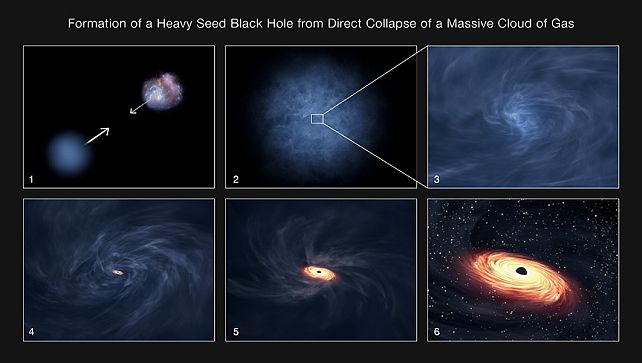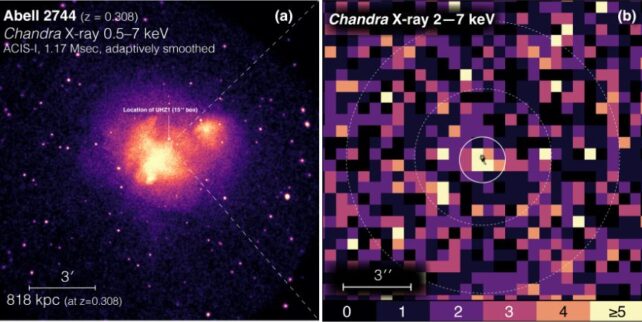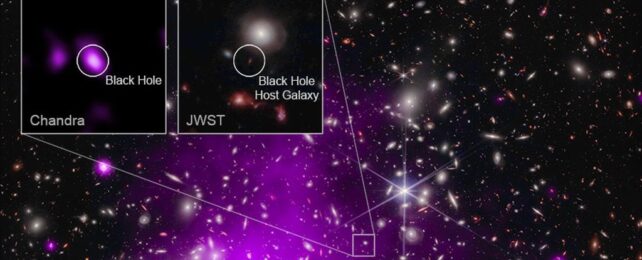A supermassive black hole smack-bang in the Cosmic Dawn has broken the record for the earliest black hole we've ever seen.
It's been spotted in a galaxy known as UHZ1, just 470 million years after the Big Bang, a time period when the Universe was still just a baby. In fact, it's so early in the Universe that the black hole is at a stage of development we've never seen before – it's of a similar mass to the host galaxy that is growing around it.
It's so far away – with light that has traveled for 13.2 billion years to reach us – that the combined might of the Chandra X-ray observatory, the James Webb Space Telescope (JWST), and a quirk of relativity were required to find it, lurking in the murky depths of time and space.
The discovery, according to a team led by astrophysicist Akos Bogdan of the Harvard-Smithsonian Center for Astrophysics (CfA), constitutes key evidence for the mode of supermassive black hole formation that requires the direct gravitational collapse of a huge cloud of gas into an ultradense object that then grows larger and larger as time marches on.
"There are physical limits on how quickly black holes can grow once they've formed, but ones that are born more massive have a head start," says astrophysicist Andy Goulding of Princeton University. "It's like planting a sapling, which takes less time to grow into a full-size tree than if you started with only a seed."

The thing about supermassive black holes is that they are almost incomprehensibly huge. Sagittarius A*, the supermassive black hole at the heart of the Milky Way, is a whopping 4.3 million times the mass of the Sun – and it's relatively modest, as far as supermassive black holes go.
We don't really know how these objects get so chonkulous, but one thing is becoming abundantly clear: there are way more of them in the early Universe than we expected there to be, and they are way too massive to have grown that large from something the size of a star, that soon after the Big Bang.
The best way to figure out what's going on is to take a look-see and make deductions based on what we observe, but that first part is far easier said than done.
The Cosmic Dawn, which covers the first billion years or so after the Big Bang, is very far away indeed, and any light in those distant reaches is very dim and very red, attenuated by the stretch of expanding space-time.

JWST is the most powerful space telescope ever built, and it sees the Universe in that red light. Even so, that's not quite enough.
To spot UHZ1, Bogdan and his team leveraged a quirk of relativity called a gravitational lens. These exist because a huge amount of gravity in one spot, such as the gravity of a cluster of galaxies, causes space-time itself to curve around it. Any light traveling through that curved space-time from more distant parts of the Universe can become magnified, replicated, and distorted.
UHZ1 lies beyond a cluster of galaxies about 3.5 billion light years away called Abell 2744, the gravity of which caused a fourfold magnification of UHZ1's light. This meant that JWST could discern the light of the galaxy itself; and Chandra was able to make out the X-radiation emitted by gas swirling around the supermassive black hole at its center.
From this light, Bogdan and his team estimated the mass of both the black hole, and the galaxy around it. If the black hole is scarfing down material at the maximum rate it can, its mass is between 10 million and 100 million times the mass of the Sun. And that's about the same mass as the rest of the stars in the galaxy UHZ1 combined, the researchers found.

Typically, the ratio of the mass of a black hole to that of its host galaxy is about half a percent. The masses involved here suggest that UHZ1 and its black hole are still in their very baby stages – and that the black hole seed must have formed from a direct collapse, rather than slow accretion.
"We think that this is the first detection of an 'Outsize Black Hole' and the best evidence yet obtained that some black holes form from massive clouds of gas," says astrophysicist Priyamvada Natarajan of Yale University. "For the first time we are seeing a brief stage where a supermassive black hole weighs about as much as the stars in its galaxy, before it falls behind."
That's not to say that the slow accretion model can't also be true, at least for some supermassive black holes. But the evidence is cumulatively suggesting that, in the very early Universe at least, direct collapse is the best way to make a super large black hole.
Even still, we've barely scratched the surface of what JWST might find in the early Universe. The murky dawn of time no doubt has more surprises for us yet.
The research has been accepted into Nature Astronomy, and is available on preprint server arXiv.
